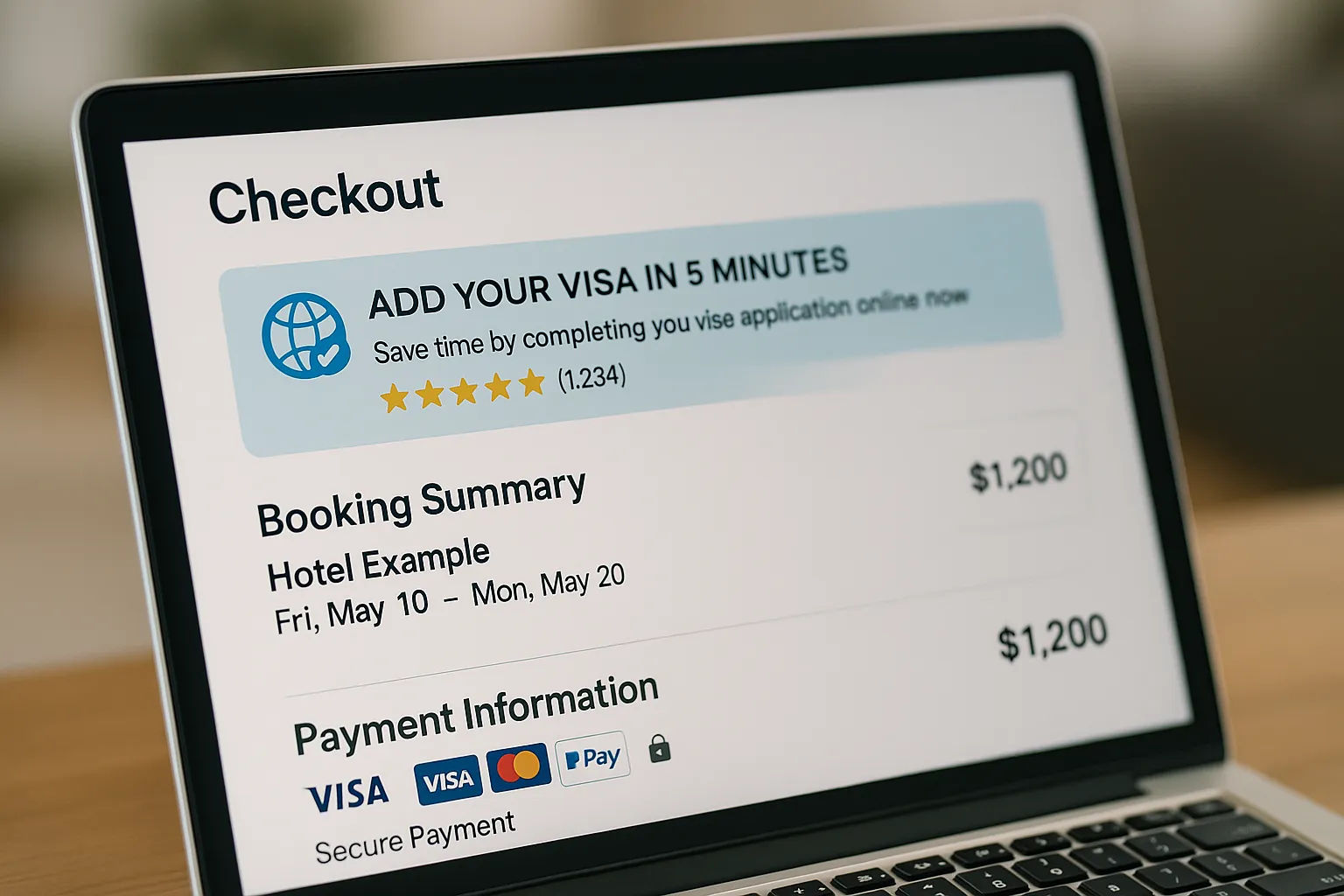How to Evaluate a Visa Processing Company

Choosing the right visa processing company can feel overwhelming, especially when traveler expectations, border regulations and commercial pressures are all moving targets. A single documentation error can cost an airline a denied-boarding fine, an OTA a lost booking, or a tour operator a reputation hit. According to IATA, carriers pay more than US $3.5 billion every year in fines, re-accommodation and support costs tied to documentation problems. With new programs such as ETIAS and UK ETA coming online, those numbers are only expected to rise.
The good news is that modern visa processing platforms can automate 95 percent of the paperwork, keep requirements up to date in real time and even unlock ancillary revenue. The challenge is separating marketing hype from operational reality. This guide walks you through a practical, data-driven framework to evaluate any visa processing company and pick a partner that will protect your customers, your brand and your bottom line.
1. Understand the Landscape
Not all providers solve the same problem. Before sending an RFP, clarify which category you need:
- Data-only APIs – surface entry requirements without managing applications.
- Application engines – collect traveler data, pre-fill government forms and submit on the customer’s behalf.
- Full-stack platforms – combine rules data, application flows, payment, status tracking, customer support and white-label UX.
Knowing your required scope will prevent feature creep and reduce integration time. If you want to embed a quick visa upsell inside your booking flow, a full-stack platform like SimpleVisa’s widget can launch in days. If you already have an in-house portal and only need regulatory data, a raw API feed may suffice.
2. Nine Core Evaluation Criteria
A robust comparison goes beyond price tables. Use the nine criteria below to score each vendor on a 1–5 scale and create a defensible shortlist.
| Criterion | Why It Matters | Questions to Ask |
|---|---|---|
| Global Coverage & Accuracy | Missing or outdated rules trigger fines and denied boardings | How often is the rule engine updated? What is the average age of a rule? Does the vendor carry insurance? |
| Integration Options | Faster time to market means quicker ROI | Do you offer API, SDK, no-code widget and white-label? What is the average deployment time for each? |
| User Experience & Automation | Conversion drops 5–7 percent with every extra click | Can customers auto-capture passports on mobile? Is the form dynamic? What is the average abandonment rate? |
| Security & Compliance | Visa data includes passports and biometrics – breaches are brand-killers | Which standards do you certify against (ISO 27001, SOC 2, PCI-DSS)? Do you provide MFA, data tokenization, deletion workflows and signed webhooks? |
| Approval Rate & SLA | Low approval is lost revenue | What is your rolling 12-month approval rate? Do you offer money-back SLAs? |
| Ancillary Revenue Potential | Visa upsells can add 4–12 USD per booking (SimpleVisa dataset, 9.4 m bookings 2025) | What pricing and revenue-share models exist? Will you white-label checkout so users stay on my domain? |
| Support & Expertise | Real humans shorten queues when rules change overnight | Do you staff 24 x 7 multilingual support? What is your average first-response time? |
| Pricing & Total Cost of Ownership | Hidden fees erode margins | Is pricing per application, per passenger, per API call or subscription? Any setup or maintenance fees? |
| References & Certifications | Social proof builds confidence | Can we speak with an airline, OTA and cruise line reference? Do you publish audit reports? |
Tip: Weight each column according to your strategic priorities (for example, 25 percent security, 20 percent conversion, 15 percent coverage) and calculate a composite score.
3. Drill Down on Security (Non-Negotiable)
Visa processing touches the most sensitive traveler data – passports, selfies, payment cards. One breach can trigger multimillion-dollar fines under GDPR or CCPA. At a minimum, demand the eight controls outlined in SimpleVisa’s Top 8 Security Features to Demand in Any Electronic Visa Solution:
- End-to-end AES-256 encryption in transit and at rest
- Universal multi-factor authentication for staff and partners
- Certified biometric liveness checks
- Continuous watch-list screening against Interpol and OFAC
- Data minimisation and scheduled deletion
- Immutable audit logs with tamper evidence
- AI-driven fraud analytics
- Hardened, rate-limited APIs with role-based access control
Ask vendors to provide the latest penetration-test summary and ISO 27001 certificate. If they hesitate, walk away.
4. Integration: API vs White-Label vs No-Code
The perfect feature set is useless if your engineers cannot ship it. Use the matrix below (adapted from API vs. White-Label App: Which Visa Integration Model Suits You?) to decide.
| Model | Typical Time to Market | Engineering Resources | UX Control | Best For |
|---|---|---|---|---|
| No-Code Widget | 1–3 days | None | Low (theme & logo) | OTAs testing attach-rate potential |
| White-Label Portal | 1–2 weeks | Minimal (DNS, SSO) | Medium | Airlines, cruise lines needing branded flow without code |
| REST/GraphQL API | 3–6 weeks | Front-end + back-end | Full | Enterprises embedding visas deep in booking engine |
Remember indirect costs: manual visa handling can consume up to 14 minutes of agent time per booking (Phocuswright, 2024). Automating those minutes often pays back integration costs within one quarter.
5. Hidden Costs and ROI
Manual workarounds – emailing PDF forms, re-entering data, chasing embassies – create invisible drag. Our own analysis in The Hidden Costs of Manual Visa Processing shows average fully loaded cost at US $17.40 per booking before fines. Multiply that by 500 000 annual passengers and you are burning US $8.7 million.
A modern platform generates value in three buckets:
- Revenue lift – visas, ETAs and transit permits add incremental per-booking margin.
- Cost reduction – fewer support tickets, lower denied-boarding penalties.
- NPS boost – happy travelers rebook and leave positive reviews, reducing acquisition spend.
When comparing vendors, request an ROI model that spans all three buckets – and sanity-check the assumptions.
6. Build a 14-Point RFP Checklist
Use the questions below (copy-and-paste ready) to standardize proposals and avoid apples-to-oranges comparisons.
- Which countries and document types do you cover? Provide a coverage matrix.
- How frequently are rules updated and by whom?
- List integration options and average live-date statistics.
- Share last 12-month approval rate by destination.
- Provide two airline and two OTA references with contact details.
- Detail security certifications, audit frequency and past incidents.
- Describe data retention and deletion policies.
- Outline support hours, languages and SLAs.
- Explain revenue-share, markup or subscription pricing tiers.
- Show sample traveler journey screens (desktop and mobile).
- Include sandbox credentials and OpenAPI spec.
- Share KPIs partners typically track post-launch (see 5 KPIs to Track After Deploying a Visa Management Platform).
- Confirm compliance with GDPR, CCPA and local data laws.
- Detail disaster-recovery objectives (RPO, RTO) and uptime guarantees.
7. Red Flags to Spot Early
- Opaque pricing – vague “variable admin fees” without a rate card.
- Static rulebooks – requirements updated via CSV once a month.
- No sandbox – prevents engineers from testing edge cases.
- Single-tenant data storage without encryption – risk of breach.
- Pushy upsells before reference calls – confidence comes from product, not pressure.
8. Case Snapshot – 60-Day Payback
A mid-size European OTA embedded SimpleVisa’s no-code widget across checkout and post-booking emails. Key results:
- Go-live time: 3 days
- Attach rate: 11.8 percent (versus control 0 percent)
- Incremental ancillary revenue: €4.30 per passenger
- Customer-service tickets about visas: -57 percent
- Payback period: <60 days

9. Onboarding and Continuous Improvement
A vendor’s job starts, not ends, at launch. Ask how they help you iterate:
- Weekly conversion reports and A/B test suggestions
- Quarterly business reviews with benchmarking data
- Real-time alerting when border rules change
Platforms like SimpleVisa expose webhook events so your CRM or BI tool can trigger automated emails, loyalty offers or fraud checks based on visa status.
Frequently Asked Questions
How much engineering effort should I budget for an API integration? A typical implementation with SimpleVisa takes two front-end and one back-end engineer about three weeks, including sandbox testing and staging go-live.
Can I keep control of the customer relationship if I use a white-label portal? Yes, white-label portals run on your sub-domain, inherit your branding, and you receive full funnel analytics plus revenue-share reports.
What happens if new programs like ETIAS delay their rollout? Modern platforms decouple front-end flows from rule engines. If launch dates slip, the UI simply hides the product until the rule flips to active, so there is no wasted work.
Is storing passport images in the cloud legal under GDPR? It is permissible provided the processor uses a lawful basis (contract performance), encrypts data, deletes it after purpose is fulfilled, and offers Data Processing Agreements. Always verify vendor documentation.
Can I start with a widget and migrate to a full API later? Absolutely. SimpleVisa partners often validate demand with no-code components, then upgrade to APIs for deeper personalization once commercial targets are met.
Ready to Turn Compliance Into Profit?
If you are serious about reducing denied-boarding fines, boosting conversion and delighting travelers, book a 20-minute discovery call with SimpleVisa. Our team will benchmark your current process, run a free ROI analysis and spin up a sandbox in less than 24 hours so your engineers can see real responses – no slideware, just live data.
Visit simplevisa.com to schedule your demo today and discover how border-crossing administration can move from pain point to profit center.